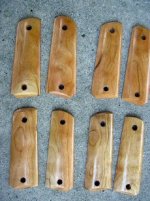Iosso makes a reusable product called Quickstrip for both bluing and parkerizing (
http://www.iosso.com/metal.htm). It doesn't tend to etch and activate steel to the degree hydrochloric (aka muriatic) acid will. Either way, keep a spray bottle of formula 409 cleaner and zap all exposed surfaces with it after removing the blue. It is a high alkalinity cleaner, capable of actually etching aluminum (no aluminum must be allowed anywhere near any bluing stripping solution). It is also a super wetting agent and degreaser and will penetrate and neutralize all acids. I always spray newly parkerized parts with it, then rinse it off and boil the part in de-ionized water (distilled will work, too) before final oil application.
The boiling step does two things: Fisrt, it clears any trace of residue from any of the chemicals. Second, when the part is removed from the water it is hot and if you shake the excess water off sharply, the retained heat dries the rest very rapidly, leaving the hot metal exposed to the air. The hot metal in air forms a micro-blued finish on the steel that inhibits corrosion for a day or two so you can get to the next finishing step.
Hot bluing is usually a blue-black finish that mirrors (copies) any defects in the metal surface, so polishing the metal on buffing wheels is an important first step. Buffing is the most labor intensive part of the process, and you may want to do this yourself so you only have to pay to have the gun degreased, blued and oiled.
On the other hand, rust bluing is a more traditional shotgun finish. I have done this a number of times. Some steels like it better than others. The finish is more blue, less black and slightly satin in appearance. You buy a small bottle of Pilkington Rust Blue from Brownells. Go through cleaning and boiling as I described earlier. Swab on the chemical, let it form fine red rust in air (24 hours with humidity, 72 hours without), then boil it in that same de-ionized or distilled water for about 15 minutes to convert the red rust to black.
The next step is carding. You need a carding wheel on a buffer (Brownells again) or you can take some 0000 steel wool and degrease it (starting a couple of days ahead, immerse it in denatured alcohol for a couple of hours, remove it and dry it then repeat with fresh alcohol until you don't discern any oil coming out of the steel wool into the alcohol any more). Degreased steel wool rusts rapidly, but you can card (rub off) the loose blackened rust with it. If the steel wool rusts, boil it like the gun parts.
You have to repeat the swabbing and rusting and boiling and carding activities about six times to get a good final finish. It is a week's work, but it sure is pretty.
Uflyer has it right about all the finish variants. If the original finish was oiled and not glossy, I have had terrific success redoing these with Watco Danish Oil. You have to strip first, or you will get a blotchy finish. You will want to steam dents (I find a 120 Watt soldering iron with a wide chisel tip applied to wet rags over a dent works best) and get oil out of the stock (see the recent thread on that process in this forum). I mostly use the plain finish, but have also used the colored versions to match light woods to walnut. This is a particular problem with surplus Garands, with which stock stripping sometimes uncovers a walnut stock and birch hand guard, or some other mix of woods owing to past repairs.
I use a method of applying the Watco finish in 2-3 coats that I was taught by a high-end cabinet maker. Using wet/dry sandpaper, apply the first coat by dipping 320 grit paper in the oil and rubbing it in; the next day the second coat is applied with 400 grit; the third day the optional third coat is applied with 600 grit. With each coat, reapply lightly every 15 minutes until the wood surface has been kept wet with the stuff for an hour. Then wipe it completely dry with a terrycloth rag and let it hang from a modified wire cloths hanger for an hour. Re-wipe for any excess that gravity has pulled down, then let it hang overnight. Repeat 12 to 24 hours later with the next sandpaper grade; repeat 12 to 24 hours after that with the final sandpaper grade. Hang for a week before putting the gun together.
This method gets the oil deep in the grain and leaves what looks like a cross between a satin and oil finish. If you stop at the second coat, it will look more oil-like because the fine sandpaper creates its own grain filler as it works, tending to take the grain texture out, leaving a more polished surface. Because of the polyurethane resins in the Danish oil, this finish is much more weather resistant than a linseed or tung oil finish. I have seen linseed finishes grow gray mold under adverse conditions.
Nick

